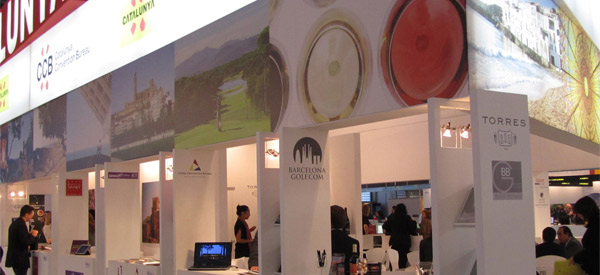[flgallery id=27 /]
What makes Catalonia – and its capital city Barcelona in Spain – unique from other destinations for events? It’s tough to narrow this down to a single concept, but I suspect the international travel industry will continue to find out more in the years ahead.
Catalonia has its own language and culture – both contributing to way this province stands out from other Spanish destinations. It also has its own gastronomy and its own sense of architecture. And then there’s the fact that it is bordered by the Mediterranean Sea and the Pyrenees.
If your focus is Barcelona, that’s probably not too surprising. In 2011, nearly 650,000 business travelers attended nearly 2300 meetings here. “The number of meetings held in the Catalan capital increased by 6.8% vs. 2010,” explains Jorge Rubio Navarrio, director at the Tourist Office of Spain in Chicago. “And the number who attended meetings in Barcelona increased by 5%.”
Rubio attributes the increase in part to the spike in the number of seminars and workshops that are organized by meeting professionals.
It certainly seems that the meetings industry recognizes that Barcelona is a meetings city. But if you’re traveling here for business you’re getting just half of the experience that Catalonia offers. The other half is found by venturing an hour outside the city in any direction.
Catalonia offers a diversity of culture, popular activities and a commitment to the travel industry that draws business investment and business tourism.
Barcelona and Spain Rank Among Top Destinations
Each year ICCA ranks which cities are the most popular for association meetings, and consistently Spain finds itself ranking somewhere in the top spots. Barcelona was ranked as the #2 most popular meeting destination in the world by ICCA in 2010, just behind Vienna which took the top spot, and Madrid was ranked as #6.
EIBTM, a global meetings and events industry exhibition, is held each year in Barcelona. In November, 2011, more than 15,300 meetings industry and travel professionals from around the world – a record for the show – descended on this city. That’s a favorable sign that global meetings and events may likely grow.
And with so many industry professionals having a chance to see first hand just how effective Barcelona is at organizing its own events, it’s no wonder that Barcelona was the host city for more than 700 congresses in 2011, including EIBTM.
Let’s explore why there’s so much interest.
Experience Barcelona
Your daytime may be be spent at the Fira Gran Via, the CCIB or the conference rooms of one of Barcelona’s popular hotels, such as Hotel Claris, Hotel Majestic or Le Meridien (among others), but experience all that Barcelona has to offer in the evenings and your free time.
Listen to a concert at the Palau de la Musica and view the collections at Museu National D’art de Catalunya museum (both make great event venues). Spend an afternoon or evening strolling through the Gothic Quarter (hire a private guide) and drink at 4Gats where Picasso and other early 20th century artists would frequent. Barcelona has an amazing range of concerts, exhibits and events. And don’t forgot to visit La Pedrera by Antoni Gaudi, La Sagrada Familia and the Picasso Museums (all must sees).
Experience Catalonia
Once you leave the larger cities in any destination, you gain a sense of what the local people truly have to offer. It’s no different in Catalonia. Within an hour, it’s possible to organize a range of incentive trips around gastronomy, culture, the mountains or water.
“You can experience the Catalan culture, our way of life and our activities. There’s skiing in the Pyranees and rafting,” says Sonia Serracarbassa, director of the Catalunya Convention Bureau. “By the sea there’s sailing, parachuting and golf. For gastronomy, we’re known for our cava and wine. So there’s modernist cellars, vinyards and wine tastings here.”
As for food and wine, Catalonia has 56 Michelin star restaurants in the region. And that’s why many planners also incorporate chefs classes into their programs. “People like Barcelona, and they love our way of life and weather. People who come here once are always asking for new places to go,” Serracarbassa adds.
Popular spots include Girona, Tarragona, Costa Brava and Sitges. For European’s visiting Catalonia, these locations are within easy access. For Americans and others, it seems a shame to travel so far to a city and not spend a few days fully experiencing the full local culture when these areas are an hour or less away.
Experience Girona
If you’re looking for a charming city near Barcelona, look no further than Girona or Tarragona. Both are walking cities that offer an incredible mix of histories, old town’s with Roman ruins, incredible gastronomy, and welcoming people.
Girona offers several four star hotels worthy of daytime meetings, such as the AC P. Bellavisita, Hotel Carlemany, Melia Girona and NH Girona. Looking for a boutique hotel? Stay where I did: Hotel Nord 1901. For larger conventions, Palau de Congressos is a modern and flexible space. After your meeting, enjoy the many restaurants and cafes. Perhaps the most popular activity is to walk the old town and a private tour is the best way to see The Cathedral and the Jewish Quarter.
The Girona Jewish Museum is a must see for any visitor. In the 12th century, there were roughly 1,000 Jews in Girona which was about 10% of the population at the time. Girona’s Jewish community existed between the 8th century until the 1942 expulsion. The museum showcases Jewish life during that time.
The museum also includes a Judiaca public library of 6,000 books and where many lectures are held throughout the year. The Girona Jewish Museum is frequently visited by academic and cultural tour groups. (A group from Israel was going through the library on the day of my visit.)
Experience Tarragona
The Romans arrived in Tarragona in the 3rd century BC. Perhaps one of the most famous images of Tarragona is the old Roman amphitheater which was built just outside of the walls at the time because there wasn’t any space inside. Today, this is a top spot to visit, and each year in the second week of May they hold a reenactment of Gladiator Games, Roman cuisine and soldiers in war.
What’s also interesting about Tarragona is that it’s old city and Roman ruins are in tact, and the local people have been very innovative in how they incorporate that architecture into their restaurants and buildings, making very creative use of it today.
Tarragona is within easy access for a day trip from Barcelona, but it’s also worthy of serving as its own destination. Palau Firal – Congressos de Tarragona offers a space for large congresses and meetings. There’s a unique wall of natural rock build into the architecture of the building that’s reminiscent of the city’s Roman architecture.
Barcelona Weather Likely Plays a Factor
The most popular time of the year for business travel meetings and events occurs from fall through spring. Unlike many of the central and northern European destinations, weather in Catalonia is generally mild and sunny during this time.
Spain, which stretches into southern Europe, is known for its hot summers. But in late November and early December, it’s not unusual to find yourself strolling the old town streets of the Gothic Quarter or walking La Rambla with little more than a sweater or light jacket.
Will Future Business Travel Trends Impact Spain?
Hotel pricing trends in Europe is expected to fall within the transient rate increase prediction of 0.5% to 4.5% for mid-range properties and 1-5% for upper range locations, according to the American Express Global Business Travel Forecast 2012.
However, hotel pricing in Spain is expected to fall below this level – from -1.1% to 4.4% for mid-range hotels and -1.1% to 2.9% for upper range hotels. This seems like a favorable message for planners and business travelers attending programs in Spain and its major cities, including Barcelona and Madrid.
The challenge (and opportunity) for Spain and other European destinations is that lead times will continue to shrink because of economic factors that are likely to impact decisions about meetings.
The U.S. is one of many major sources of international business visitors to Spain, so it’s important to first consider the impact of air travel costs in North America. U.S. global group air trends, according to the Global Business Travel Forecast 2012, identified most domestic travel cost increases of 2-7% depending on class of seat, as well as long haul travel at 0.5% – 5% increases for economy and business fares. This seems like it could potentially be a favorable message for the number of U.S. business travelers heading overseas.
Europe, Latin America and Asia air fare generally seem to mirror a similar forecast (with Australia, Hong Kong and China experiencing greater increases).
An interesting trend noted in the Global Business Travel Forecast is that many European planners are increasing their budgets on technology and evaluating virtual meeting options to host meetings in multiple locations to save money. (Check out Spain’s virtual online exhibit for 2012 and sign up to speak with Spanish destinations and event venues.)
Three factors that impact where meeting professionals and business travelers will visit include safety concerns, exchange rates and reputations of hotels (including meeting space). Again, these factors remain favorable for Spanish destinations. Other factors include availability for access/proximity to airports, activities and restaurants.
The Catalunya Convention Bureau is comprised of 13 convention bureaus and more than 120 private and public members.





